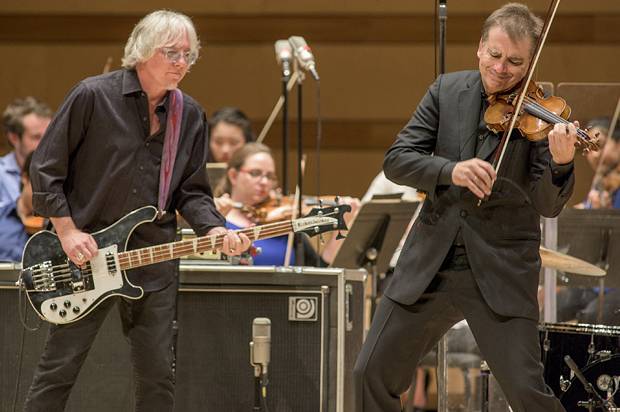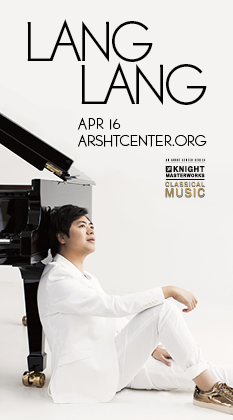Adams and Glass works outshine Mills’ violin concerto hybrid at Arsht Center

Violinist Robert McDuffie and Mike MIlls performed Mills’ Concerto for Violin, Rock Band and String Orchestra Thursday night at the Arsht Center. File photo: Sacks & Co./Alex Irvin
Youthful fans of rock star Mike Mills turned out in droves Thursday night at the Arsht Center for a performance of his initial foray into classical composition. But they also got a crash course on the work of two of America’s leading contemporary composers.
This touring show featured violinist Robert McDuffie, Mills, a pick-up band and the Fifth House Ensemble.
Road Movies, John Adams’ three-movement suite for violin and piano, depicts a drive down the open road with musical scents from the surrounding environment. One of Adams’ first chamber works, composed in 1995, the score is a compendium of country music, swing and updated impressionism viewed through Adams’ post-minimalist lens. There is a not a note too many in this compact fifteen minute work and Adams does not allow his populist influences to diminish the craft or technical demands of his enchanting vignettes.
McDuffie can play probing Bach and Mozart and high-voltage Tchaikovsky but he is also a terrific exponent of modernist scores. (His recordings of violin concertos by Adams and Philip Glass are outstanding.) He brought plush tone, stunning technical flexibility and terrific enthusiasm and abandon to Adams’ high-flying violin writing. Although no announcement was made, Elizabeth Pridgen, McDuffie’s frequent recital partner, replaced Christopher Taylor in the important keyboard part. In the meditative second movement, Pridgen eloquently performed the richly chromatic pianistic writing without distracting from the violin’s dominance. The perpetual motion of the finale, “40% Swing,” found McDuffie and Pridgen playing at race-car speed in a display of dauntless technique.
Philip Glass’s Symphony No. 3 for string orchestra is one of the iconic American minimalist’s finest works. Constant rhythm does not obscure edgy and dark undercurrents in this ambitious four-movement essay, spanning nearly a half-hour. The second movement scherzo is an almost balletic blend of jazz and Prokofiev with a final chord on the solo double bass providing a witty surprise conclusion. A pensive slow movement charged with bitter seasoning turns into a neo-Baroque concerto-grosso, setting two violins against the ensemble. Glass’s hard-driving finale puts an exclamation point on this accessible but hard-edged symphony.
The sixteen players of Fifth House Ensemble, a Chicago-based contemporary music group, sounded nearly twice as large. Under the vigorous direction of the unaccredited conductor Eli Chen, the players displayed bracing precision and subtlety. The superb articulation of the lower strings was particularly notable. Chen ratcheted up the intensity level during the course of the slow movement and drew appropriately brusque sonority in the final section.
The combination of rock and classicism usually makes for a problematical brew. The two musical genres are fundamentally different with the structured discipline of one form clashing with the wildness and unbridled energy of the other. (Like all generalizations, there are exceptions. Some rock artists are conservatory trained.)
McDuffie and Mills, bassist for the alternative rock band R.E.M., were high school chums in Macon, Georgia. They recently reconnected when McDuffie returned to his home state to run the string program at Mercer University. Commissioned by McDuffie, Mills’ Concerto for Violin, Rock Band and String Orchestra is hardly a concerto in the traditional sense. It is really a six-movement suite with song-titled movements. The program states that the work’s “orchestration and additional music” are by David Mallamud, which further complicates this uneasy fusion: how much of the score is really by Mike Mills?
The resulting collaboration works best during those sections that are pure, unadorned rock. Indeed the thirty-minute-plus work would benefit by omitting two of the movements.
The opening and closing sections (titled “Play It Like You Mean It” and “You Can Go Home Again”) found McDuffie prancing about the stage like a real rocker and imitating the sound of the electric guitars and basses in an exciting manner. Is McDuffie the only artist who has ever played rock on a Guarneri? He really caught Mills’ bass groove and Chen and his string players threw themselves into the musical mashup.
Yet when the music attempted lyricism, the disparate elements tended to fall apart. “On the Okeefenokee” sounded like a synthesized film soundtrack with the violin and orchestra superimposed and Mills’ R.E.M. hit “Nightswimming” was totally out of its element as a piano-violin-string ensemble exercise. On the other hand “Stardancers’ Waltz” was a tuneful melody of the Mark O’Connor Appalachian variety that gave McDuffie the opportunity to play in a wistful, sentimental manner with plenty of rubato.
Mills’ top-notch, hard working colleagues were guitarists John Neff and William Tonks and percussionist Patrick Ferguson. Amplification was well judged, loud and clear without being deafening. In response to yelps and cheers from Mills’ fans, the players repeated most of the final movement with even greater bang and punch. Clearly McDuffie and Mills believe in this score. With some serious editing, it could be salvaged to some degree, but without its classical pretensions.
Posted in Performances
Leave a Comment
Fri Oct 21, 2016
at 3:54 pm
No Comments





